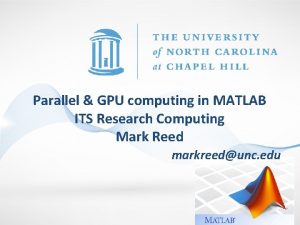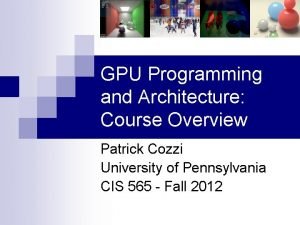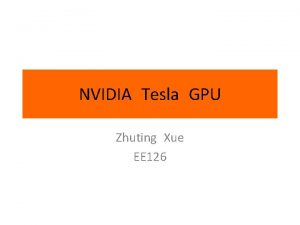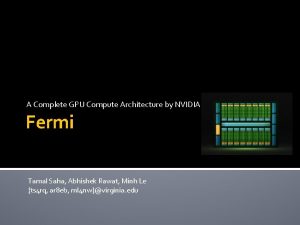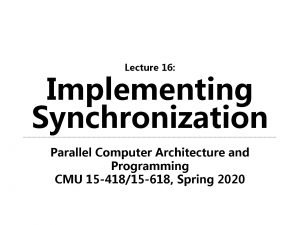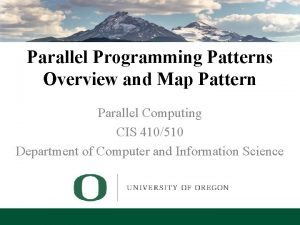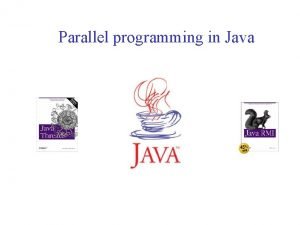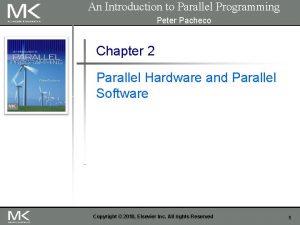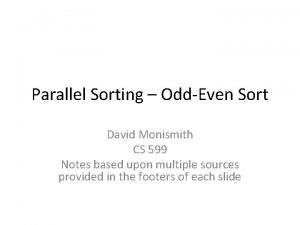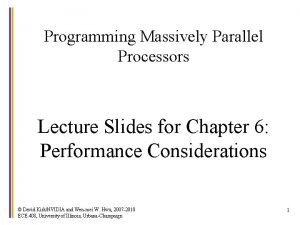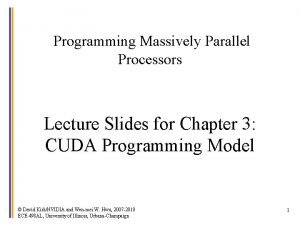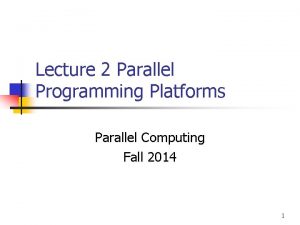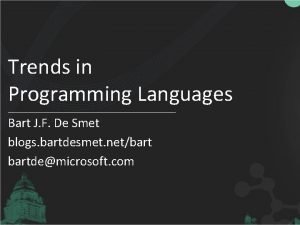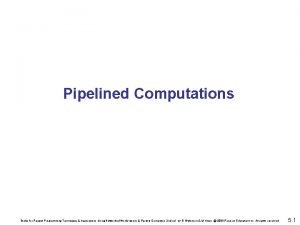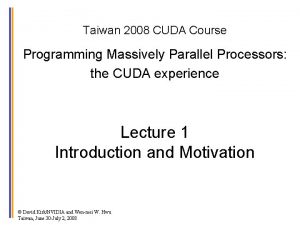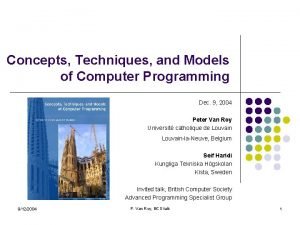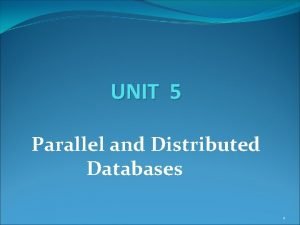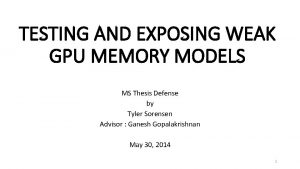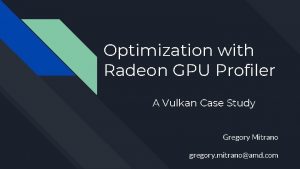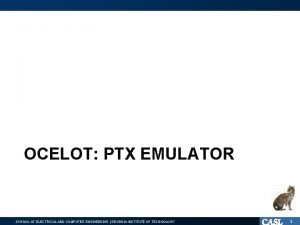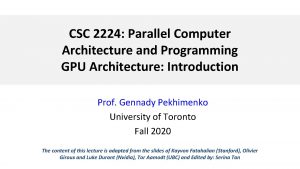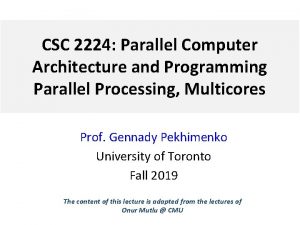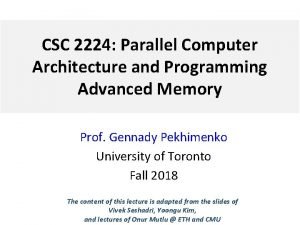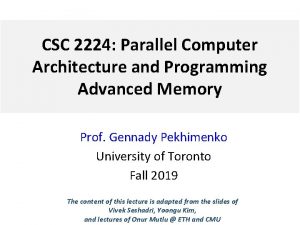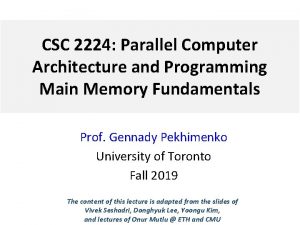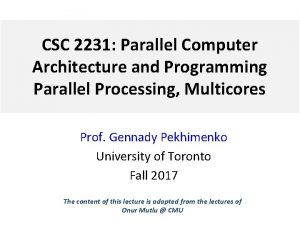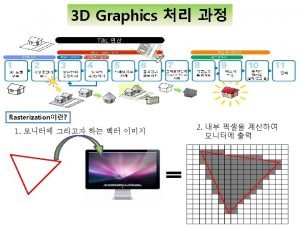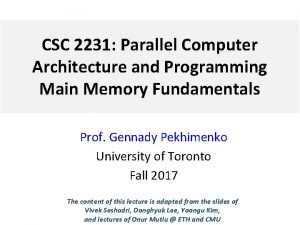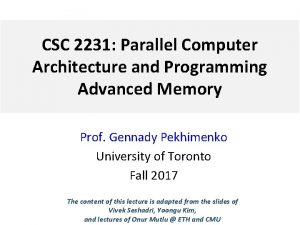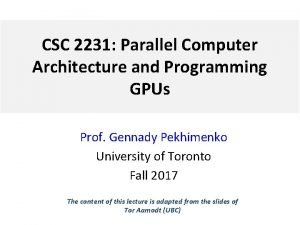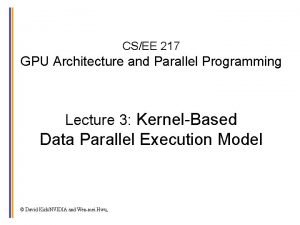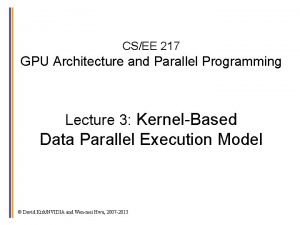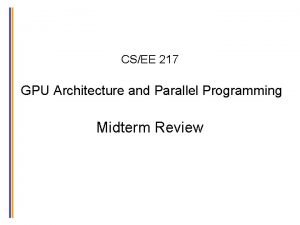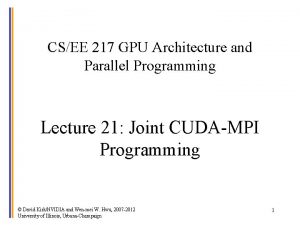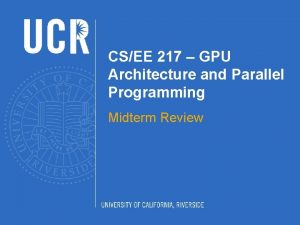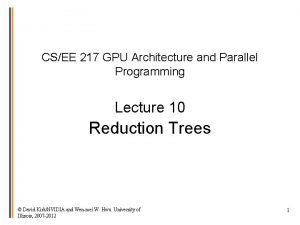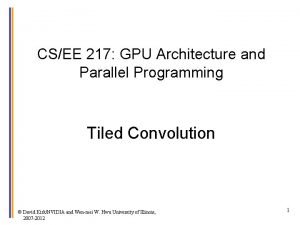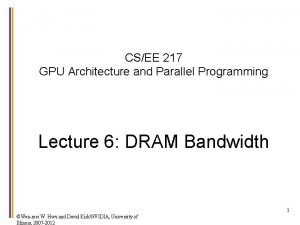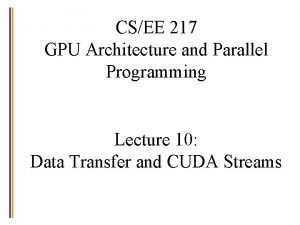CSC 2224 Parallel Computer Architecture and Programming GPU



![The GPU is Ubiquitous [APU 13 keynote] + 4 The GPU is Ubiquitous [APU 13 keynote] + 4](https://slidetodoc.com/presentation_image_h2/599bbc1117df5df5fca9f77f200cd4cb/image-4.jpg)





![Single-core CPU Execution mov R 1, 0 START: ld R 2, a[R 1] ld Single-core CPU Execution mov R 1, 0 START: ld R 2, a[R 1] ld](https://slidetodoc.com/presentation_image_h2/599bbc1117df5df5fca9f77f200cd4cb/image-10.jpg)




























- Slides: 38

CSC 2224: Parallel Computer Architecture and Programming GPU Architecture: Introduction Prof. Gennady Pekhimenko University of Toronto Fall 2019 The content of this lecture is adapted from the slides of Kayvon Fatahalian (Stanford), Olivier Giroux and Luke Durant (Nvidia), Tor Aamodt (UBC) and Edited by: Serina Tan

https: //www. youtube. com/watch? v=-P 28 LKWTzr. I

What is a GPU? • GPU = Graphics Processing Unit – – Accelerator for raster based graphics (Open. GL, Direct. X) Highly programmable (Turing complete) Commodity hardware 100’s of ALUs; 10’s of 1000 s of concurrent threads NVIDIA Volta: V 100 3
![The GPU is Ubiquitous APU 13 keynote 4 The GPU is Ubiquitous [APU 13 keynote] + 4](https://slidetodoc.com/presentation_image_h2/599bbc1117df5df5fca9f77f200cd4cb/image-4.jpg)
The GPU is Ubiquitous [APU 13 keynote] + 4

“Early” GPU History – 1981: – 1996: – 1999: – 2001: – 2002: – 2005: – 2006: IBM PC Monochrome Display Adapter (2 D) 3 D graphics (e. g. , 3 dfx Voodoo) register combiner (NVIDIA Ge. Force 256) programmable shaders (NVIDIA Ge. Force 3) floating-point (ATI Radeon 9700) unified shaders (ATI R 520 in Xbox 360) compute (NVIDIA Ge. Force 8800) 5

Why use a GPU for computing? • GPU uses larger fraction of silicon for computation than CPU. • At peak performance GPU uses order of magnitude less energy per operation than CPU 2 n. J/op Rewrite Application GPU 200 p. J/op Order of Magnitude More Energy Efficient However…. Application must perform well 6

Agenda • Three key ideas that make GPUs run fast • GPU memory hierarchy • Closer look at a modern GPU architecture (Nvidia’s Volta) • Memory: higher bandwidth, larger capacity • Compute: application-specific hardware 7

Why GPUs Run Fast? • Three key ideas behind how modern GPU processing cores run code • Knowing these concepts will help you: 1. Understand GPU core designs 2. Optimize performance of your parallel programs 3. Gain intuition about what workloads might benefit from such a parallel architecture 8

Example Program: Vector Multiply-Add • Compute v = a ∙ b + c (a, b, c and v are vectors with a length of N) a �� b void mul_add (int N, float* a, float* b, float* c, float* v) { for (int i = 0; i < N; i++) { v[i] = a[i] * b[i] + c[i] } } + c = v 9
![Singlecore CPU Execution mov R 1 0 START ld R 2 aR 1 ld Single-core CPU Execution mov R 1, 0 START: ld R 2, a[R 1] ld](https://slidetodoc.com/presentation_image_h2/599bbc1117df5df5fca9f77f200cd4cb/image-10.jpg)
Single-core CPU Execution mov R 1, 0 START: ld R 2, a[R 1] ld R 3, b[R 1] ld R 4, c[R 1] madd R 5, R 2, R 3, R 4 st R 5, v[R 1] add R 1, 1 bra START if R 1 < N 10

Single-core CPU Execution madd stalled, jump to the next independent instruction Can also be executed out-of-order through register renaming mov R 1, 0 START: ld R 2, a[R 1] ld R 3, b[R 1] ld R 4, c[R 1] madd R 5, R 2, R 3, R 4 st R 5, v[R 1] add R 1, 1 bra START if R 1 < N … 11 Instruction Flow

Single-core CPU Execution But what if we tell the hardware these two blocks can be executed in parallel to begin with? mov R 1, 0 START: ld R 2, a[R 1] ld R 3, b[R 1] ld R 4, c[R 1] madd R 5, R 2, R 3, R 4 st R 5, v[R 1] add R 1, 1 bra START if R 1 < N … 12 Instruction Flow

Slimming Down Idea #1: Use increasing transistor count to add more cores to the processor … rather than use transistors to increase sophistication of processor logic that accelerates a single instruction stream (e. g. , out-of-order and speculative operations) 13

Two cores (Two Elements in Parallel) Element x Element y START: ld R 2, a[R 1] ld R 3, b[R 1] ld R 4, c[R 1] madd R 5, R 2, R 3, R 4 st R 5, v[R 1] add R 1, 1 Result x Result y 14

Sixteen Cores But wait… Different elements in the vector are running the exact same instructions! START: ld R 2, a[R 1] ld R 3, b[R 1] ld R 4, c[R 1] madd R 5, R 2, R 3, R 4 st R 5, v[R 1] add R 1, 1 16 cores = 16 simultaneous instruction streams 15

Instruction Stream Sharing Idea #2: Amortize cost/complexity of managing an instruction stream across many ALUs SIMD processing! 16

128 Elements in Parallel 16 cores �� 8 ALUs/core = 128 ALUs 16 cores = 16 simultaneous instruction streams 17

What about Branches? <unconditional shader code> if (x > 0) { y = pow(x, exp); y *= Ks; refl = y + Ka; } else { x = 0; refl = Ka; } <resume unconditional shader code> 18

What about Branches? <unconditional shader code> if (x > 0) { y = pow(x, exp); y *= Ks; refl = y + Ka; } else { x = 0; refl = Ka; } <resume unconditional shader code> 19

What about Branches? <unconditional shader code> if (x > 0) { y = pow(x, exp); y *= Ks; refl = y + Ka; } else { x = 0; refl = Ka; } <resume unconditional shader code> Not all ALUs do useful work! Worst case: 1/8 peak performance 20

SIMD Execution on Modern GPUs • • “Implicit SIMD” • Compiler generates a scalar binary (scalar as opposed to vector instructions) • But N instances of the program are *always running* together on the processor i. e. , execute(my_function, N) // execute my_function N times • Hardware (not compiler) is responsible for simultaneously executing the same instruction on different data in SIMD ALUs SIMD width in practice • 32 on NVIDIA GPUs (a warp of threads) and 64 on AMD GPUs (wavefront) • Divergence can be a big issue (poorly written code might execute at 1/32 the peak capability of the machine!) 22

Dealing with Stalls on In-order Cores • Stalls occur when a core cannot run the next instruction because of a dependency on a previous long-latency operation • We’ve removed fancy logic that helps avoid stalls • • No more out-of-order execution to exploit instruction-level parallelism (ILP) • Traditional cache doesn’t always help since a lot of workloads are streaming data But, we have a LOT of parallel work… Idea #3: Interleave processing of many warps on a single core to avoid stalls caused by high-latency operations 23

Time (clock cycles) Hiding Stalls Element 1… 8 1 Element 9… 16 Element 17… 24 3 2 24 Element 25… 32 4

Time (clock cycles) Hiding Stalls Element 1… 8 1 Element 9… 16 Element 17… 24 3 2 Runnable 25 Element 25… 32 4

Time (clock cycles) Hiding Stalls Element 1… 8 1 Element 9… 16 Element 17… 24 3 2 Element 25… 32 4 Runnable Done! 26

Throughput Computing Trade-off Time (clock cycles) Element 1… 8 1 Runnable Element 9… 16 Element 17… 24 3 2 Element 25… 32 4 During this time, this group is runnable, but it is not being executed by the processor. (The core is running some other group. ) Done! Key idea of throughput-oriented systems: Potentially increase runtime of one group, in order to increase throughput of overall system running multiple groups. 27

Storing Execution Contexts • • Consider on-chip storage of execution contexts a finite resource Resource consumption of each thread group is program-dependent Execution Context Storage 28

Four Large Contexts (Low Latency Hiding) 29

Eighteen Small Contexts (High Latency Hiding) 30

Summary: Three Key Ideas 1. Use many “slimmed down cores” to run in parallel 2. Pack cores full of ALUs (by sharing instruction stream on multiple data) 3. Avoid latency stalls by interleaving execution of many groups of threads • When one group stalls, work on another group 31

CPU v. s. GPU Memory Hierarchies CPU: Big caches, few threads per core, modest memory BW Rely mainly on caches and prefetching GDD R 5 NVIDIA GTX 1080 (Pascal) GPU: Small caches, many threads, huge memory BW Rely heavily on multi-threading for performance 32

Thought Experiment • Consider element-wise multiplication of two vectors a and b • Assume vectors contain millions of elements • Load input a[i] • Load input b[i] • Compute a[i] �� b[i] • Store result into v[i] a b v �� = • Three memory operations (12 bytes) for every MUL • NVIDIA GTX 1080 GPU can do 2560 MULs per clock (@ 1. 6 GHz) • Need ~45 TB/sec of bandwidth to keep functional units busy (only have 320 GB/sec) <1% GPU efficiency… but 4. 2 x faster than eight-core CPU in lab! (3. 2 GHz Xeon E 5 v 4 eight-core CPU connected to 76 GB/sec memory bus will exhibit ~3% efficiency on this computation) 33

Bandwidth limited! If processors request data at too high a rate, the memory system cannot keep up. No amount of latency hiding helps this. Overcoming bandwidth limits are a common challenge for application developers on throughput-optimized systems.

Bandwidth is a Critical Resource Performant parallel programs will: • • Organize computation to fetch data from memory less often • Reuse data previously loaded by the same thread • Share data across threads through scratchpad (inter-thread cooperation) • Access contiguous memory within the same warp (hardware managed memory coalescing) Request data less often (instead, do more arithmetic: it’s “free”) • Useful term: “arithmetic intensity” — ratio of math operations to data access operations in an instruction stream • Main point: programs must have high arithmetic intensity to utilize modern processors efficiently 35

Memory Spaces in GPU On-chip: - Register file - Usage determined by compiler - Spills go to local memory - Shared memory, i. e. scratchpad - Programmer managed - Bank conflicts - L 1 cache SM 0 Compute Cores Register File (fast) SM n SM 1 Shared Memory (med) L 1 Cache (Slow) … Per thread Off-chip: - L 2 cache - Bandwidth filter for DRAM rather than reducing latency as in CPUs - Device memory (DRAM) - Several spaces: global memory, texture memory, local memory - Different spaces have different caching policies Per thread block All resident threads L 2 Cache (slow+) Device Memory (slow++) 36

Modern GPU Architecture (Volta 2017) 21 B transistors 2 815 mm 80 SM 5120 CUDA Cores 640 Tensor Cores 16/32 GB HBM 2 900 GB/s HBM 2 300 GB/s NVLink *full GV 100 chip contains 84 SMs 37

Review #7 GPUs and the Future of Parallel Computing Steve Keckler et al. , IEEE Micro 2011 Due Nov. 11 38

CSC 2224: Parallel Computer Architecture and Programming GPU Architecture: Introduction Prof. Gennady Pekhimenko University of Toronto Fall 2019 The content of this lecture is adapted from the slides of Kayvon Fatahalian (Stanford), Olivier Giroux and Luke Durant (Nvidia), Tor Aamodt (UBC) and Edited by: Serina Tan
 Matlab parallel computing gpu
Matlab parallel computing gpu Githubn
Githubn Tesla gpu architecture
Tesla gpu architecture Gpu architecture basics
Gpu architecture basics Explain the concept of nano programming
Explain the concept of nano programming Parallel computer architecture cmu
Parallel computer architecture cmu Parallel priority interrupt
Parallel priority interrupt Difference between architecture and organisation
Difference between architecture and organisation Three bus architecture
Three bus architecture Design of basic computer in computer architecture
Design of basic computer in computer architecture Define the resultant of unlike parallel forces
Define the resultant of unlike parallel forces Annie's dress was old, faded, and it had wrinkles.
Annie's dress was old, faded, and it had wrinkles. Owl parallel structure
Owl parallel structure Parallel structure means using the same pattern of
Parallel structure means using the same pattern of What is parallel structure in english
What is parallel structure in english Perbedaan linear programming dan integer programming
Perbedaan linear programming dan integer programming Greedy vs dynamic programming
Greedy vs dynamic programming System programming vs application programming
System programming vs application programming Linear vs integer programming
Linear vs integer programming Programing adalah
Programing adalah Programming massively parallel processors
Programming massively parallel processors Scala parallel map
Scala parallel map What is parallel programming in java
What is parallel programming in java An introduction to parallel programming peter pacheco
An introduction to parallel programming peter pacheco Bubble sort parallel programming
Bubble sort parallel programming Mpi critical section
Mpi critical section Programming massively parallel processors
Programming massively parallel processors Massively parallel processing ppt
Massively parallel processing ppt Parallel programming platforms
Parallel programming platforms F# parallel programming
F# parallel programming Parallel programming
Parallel programming Programming massively parallel processors, kirk et al.
Programming massively parallel processors, kirk et al. Concepts techniques and models of computer programming
Concepts techniques and models of computer programming Linear programming models graphical and computer methods
Linear programming models graphical and computer methods Parallel and distributed database architecture
Parallel and distributed database architecture Parallel and distributed database architecture
Parallel and distributed database architecture Gpu memory test
Gpu memory test Gpu bubble
Gpu bubble Ocelot
Ocelot
